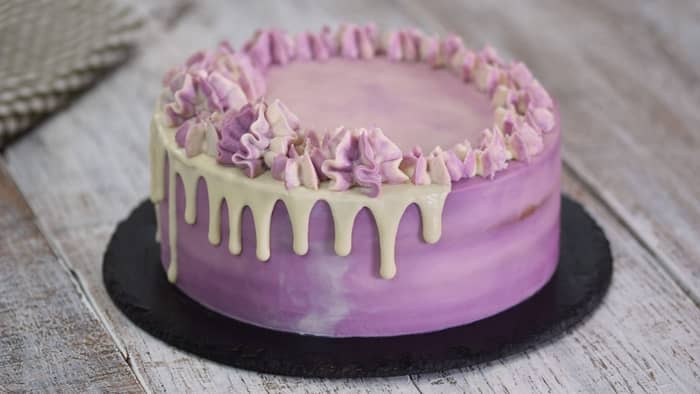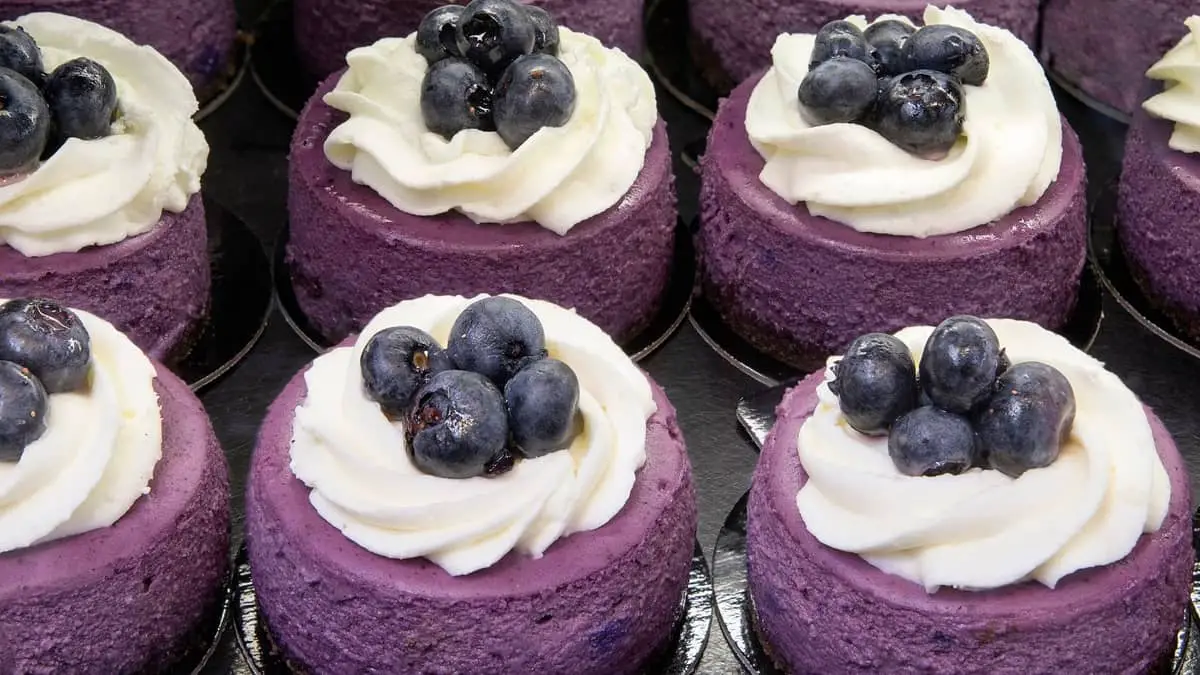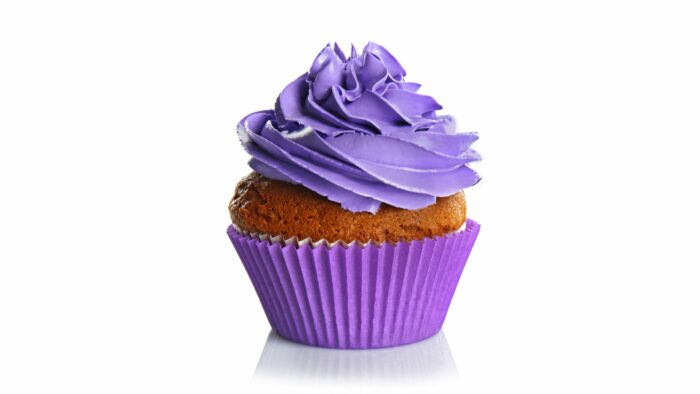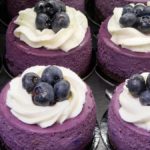Last Updated on February 6, 2023
Let’s take a look at how to make purple food coloring. Generally, you can add fifteen drops of blue food coloring with eighty drops of red food coloring to produce a basic color purple. Then, be sure to blend well. After that, make sure to utilize it when necessary.
In any case, it will undoubtedly differ depending on the quantity and kind of base you are trying to color. Because of that, it would help to test the color’s strength as you proceed.
Also, remember that it is incredibly common to over-color. In addition to that, it can be challenging to lighten the shade, especially after you add the food dye.
How to Make Purple Food Coloring
For starters, what food colors make purple? To achieve purple food coloring, you need blue and red food coloring. Afterward, you can go ahead and create a mixture of your desired proportions.

What Food Coloring Makes Purple?
For one thing, you must understand how to get excellent purple food coloring which is having to mix red food coloring and blue food coloring appropriately. With this, one should first observe the colors to make purple. Also, it would help to see where the colors belong on the color wheel.
Remember that the primary colors are the main shades that make up the fundamental color wheel; these colors consist of yellow, blue, and red. Because of this, colors derive from combinations of these three primary colors.
In that regard, the secondary colors comprise purple, green, and orange. Bear in mind that purple is a mixture of blue and red. In contrast, green is a blend of yellow and blue. On the other hand, orange is a combination of yellow and red.
The ratio for Basic Purple Color
Essentially, you have to blend blue and red at around 3:16; it means that for every three drops of blue, you have to mix in sixteen drops of red. That is why, as mentioned, you have to add in on average fifteen drops of blue food coloring with eighty drops of red food coloring.
The ratio for Light Purple Color
First, it is necessary to modify your blue-red ratios to incorporate more white. In so doing, you will obtain a light purple color like lavender or lilac. For the most part, you can do this by using pink in the food coloring mixture. Likewise, you can use light blue food coloring.
The ratio for Dark Purple Color
Most of the time, it is a requirement to have a blue: red ratio of 3:13. Because of this, be sure to have three drops of blue for every thirteen drops of red when creating a food coloring mixture.
In this regard, you will only need a tiny amount of red in the mixture to get a darker purple color. Also, for this reason, blue is indeed the source of the deeper color.
How to Make Purple?
Start by making a custom purple shade for your cake frosting; you can do this by blending blue and red food coloring into the white frosting. Keep in mind that white is indeed necessary. The main reason is that it is free from other colors. Besides, it is pretty impossible to obtain purple with a chocolate brown frosting.
Afterward, with one cup of frosting, make sure to modify the ratios depending on your recipe. In this regard, make the color of a deep grape taffy with 80 drops of blue food coloring and 180 drops of red food coloring. Next, be sure to blend them into a cup of white frosting.
Furthermore, you are free to stir in more blue; it could be about ten drops at a time. Doing this will make it darker and resemble a more royal shade of purple.
Moreover, you can resume adding ten more red and blue drops; only do this when you want to intensify the purple’s depth. After that, ensure to stir and add more until you reach the desired shade.
Natural Food Coloring
Before anything else, it is possible to make purple food coloring with different natural dyes. For this reason, blending blue and red food colorings is not the only option when making purple food coloring.
Blueberries
Bear in mind that blue is the primary color of blueberries. However, there is no denying that some purple shade is present in the blueberries’ color. In this case, you can indeed mix blueberries. Likewise, you can simmer the blueberries with heat. Afterward, make sure to remove all the juice to get the natural food coloring.
On the other hand, if it is exceedingly blue. In addition to that, it lacks the purple color; it would help to consider adding red food coloring to it. Likewise, you can add natural red juice from other fruits like strawberries.
Purple Cabbage
Typically, you can obtain the coloring from the purple cabbage by boiling it in water. After that, make sure to remove it when finished.
How to Make Purple Food Dye
It’s super easy to make purple dye and there are many ways you can do this. The easiest way is to start with a white base, and then simply add red and blue food coloring; the exact amounts will vary depending on the shade of purple that you’re looking for. For example, more red will lead to a lighter shade and more purple will lead to a darker shade.
You can also use natural food dye. When making your own purple natural food dye, you can use a range of natural foods such as blackberries, raspberries, and red cabbage. The options for foods you can use are endless!
How to Make Natural Purple Food Coloring
As mentioned above, there are many ways to use natural foods to make purple food dye or coloring. Some of the most common options include:
- red cabbage: you’ll need to remove the leaves and chop them. Add the chopped pieces to a pot of boiling water. Once the juice has been released, strain the mixture.
- berries: for this, you can use blackberries, elderberries, blueberries, raspberries, or mulberries. First, you’ll need to crush the berries and then add them to boiling water. You’ll also need to strain the mixture to avoid any seeds being in your dye.
- grapes: for best results, you can use grape juice. Boil the juice and the color will darken and reduce.
- cherry tree roots: boil the roots and you’ll have purple dye in no time!
- hibiscus: you can use fresh flowers for this, or dried ones. And then just add them to a pot of boiling water.
- blooms: for this, you can either use dark purple iris blooms or daylily blooms. For the daylily blooms, ensure they are wilted and then boil them. For the iris blooms, mix with an alum mordant.
- red maple bark: use pieces of the inner bark and add to a pot of boiling water.
- basil: this may seem like a strange one, but all you need is the leaves and even the stems. Add to a pot of boiling water for best results.
How to Make Purple Frosting
It’s super easy to make the purple frosting. The only colors you need are red and blue. However, the amount you need will depend on the shade of purple you’re looking for. It’s also important to start with white frosting as your base. No other color will work as well as a base, then white. While the amounts of food coloring may seem a lot, you can have around 100 drops of food coloring on a single teaspoon!
Ingredients:
- white frosting (1 cup to achieve the desired shade)
- red food coloring
- purple food coloring
Now all you need to do is:
- You’ll want to start with a basic purple. Add around 25 drops of blue into your frosting, along with 35 drops of red. These ratios are based on one cup of frosting
- Mix well until you reach the color you’re looking for.
How to Make Other Colors With Food Coloring
Natural food coloring is really easy to work with, and some of these ingredients you’ll already have in your pantry or refrigerator. We know how to make purple, but you may be curious about other colors. Let’s take a closer look.
- for pink: use strawberries
- for red: use tomato or beetroot
- for green: use spinach
- for orange: use carrot or sweet potato
- for yellow: use saffron
- for brown: use tea or coffee
- for black: use activated charcoal
Tips and Tricks
In general, it is crucial to consider the amount of food coloring you use to produce purple food coloring. Usually, you do not need plenty of drops of food coloring. The main reason is that it can be highly concentrated.
On the contrary, the ratio of the blue-to-red drop will undoubtedly affect how deep, dark, and bright the purple becomes.
An artist’s color wheel and a food coloring chart provide guidance that is exceedingly helpful when mixing colors to tint a particular recipe. Once again, mixing blue and red produces purple. However, the exact quantities of each color will differ relying on the kind and size of ingredients in the recipe.
Likewise, it will depend on the food coloring brand. For example, the quantity of purple needed to tint a layer cake is different when making soda water purple.
Moreover, it would be best to utilize as little food coloring as possible. Doing so will prevent your guests’ tongues and lips from becoming purple. Remember, your main objective is to have a see-through or translucent purple instead of dark purple.
Conclusion
Ultimately, when you want to make purple food coloring, blue and red are the two-color dyes required. Remember, the mixture of blue and red, two primary colors, produces a purple shade, a secondary color. Additionally, you can make different variations of the purple food coloring by utilizing other blue-to-red food dye ratios.
Nevertheless, it is best to have more red than blue to create purple. Furthermore, you can use natural food dyes like blueberries or purple cabbage. I hope this post has helped you to become more familiar with how to make purple food coloring. If you have any tips or tricks, please feel free to let us know in the comments below. Sharing is caring!
FAQs
what food coloring makes purple
For one thing, you must understand how to get excellent purple food coloring which is having to mix red food coloring and blue food coloring appropriately. With this, one should first observe the colors to make purple. Also, it would help to see where the colors belong on the color wheel.
how to make purple
Start by making a custom purple shade for your cake frosting; you can do this by blending blue and red food coloring into the white frosting. Keep in mind that white is indeed necessary. The main reason is that it is free from other colors. Besides, it is pretty impossible to obtain purple with a chocolate brown frosting.
what food colors make purple
To achieve purple food coloring, you need blue and red food coloring. Afterward, you can go ahead and create a mixture of your desired proportions.
Stunning Purple Frosting
Ingredients
- white frosting (1 cup to achieve the desired shade)
- red food coloring
- purple food coloring
Instructions
- You'll want to start with a basic purple. Add around 25 drops of blue into your frosting, along with 35 drops of red. These ratios are based on one cup of frosting.
- Mix well until you reach the color you're looking for.

Zarah is an experienced pastry chef whose creations have delighted countless customers. With a passion for baking, Zarah has developed a unique style that combines classic techniques with modern flavors. Her desserts are consistently crafted with the finest ingredients, and her attention to detail is evident in the stunning and delectable results. Zarah has a wealth of experience in the pastry kitchen, and loves to share her knowledge with others. Whether it is teaching a class or creating a custom cake for a special occasion, Zarah is committed to making sure every customer is satisfied.




